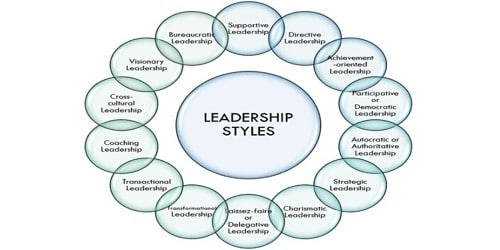Leadership Styles
Leadership is the art of motivating a group of people to act towards achieving a general goal. Leadership style is the method and approach of providing way, implementing plans, and motivating people.
Democratic Leadership – This Style is also known as participative. The subordinates are a part of the decision-making process in this type of leadership. This is a good way of increasing employee motivation and if used properly always has positive effects on the normal business of the organization. This is considered to be one of the most preferred leadership styles.
Transformational Leadership – A transformational leader inspires others by setting higher goals and motivating them to increase productivity. Employees might have a basic set of tasks and goals that they complete every week or month, but the leader is constantly pushing them outside of their relieve zone.
Team Leadership – A team leader involves his team completely in the project at hand. The leader inspires his team to work hard and together they work to accomplish the set goals and develop the members proficiently.
Strategic Leadership – It involves a leader who is mainly the head of a firm but one who does not only allocate ideas with the top management. Strategic leaders sit at the intersection between a company’s main operations and its growth opportunities. He is known to bridge the gap between the requirement for new possibilities and the need for realism.
Autocratic Leadership – Here, the leader holds all the authority. He communicates the same to his team and expects immediate implementation. He is also the one who is held responsible for his decisions. There is no flexibility here. This approach is a set of rewards and punishments. This kind of leadership has often been criticized.
Coaching Leadership -Leaders focus on helping other staff in developing their skills and abilities. A coaching leader constantly guides and supervises his team members to enhance performance. This style is best where all the people already understand their weaknesses and are receptive to all the ideas for improvement. This style of leadership has received immense appreciation.
Facilitative Leadership – A facilitative leader helps his team members run the process efficiently by giving them directions from time to time. This is almost the same as the democratic style of management but relies more on praising and appreciating the hardworking staff; unfortunately, poor performance may also go without reprimand.
Laissez-Faire Leadership – In this type of leadership, the team members are given authority. All authority is given to the staff and they determine goals, resolve problems also make decisions on their own. They are given the opportunity to work at their discretion with almost no interference from the leader. The effective use of this style is when staff is highly skilled experienced and educated. It is not considered to be an effective leadership style.
Transactional Leadership – This type of leadership includes an exchange process. This approach shows the engagement of the employees with the commitment of work in the circumstance of shared vision, shared values and shared goals as well as the set objectives.
Finally, if you believed that the leadership eminence cannot be bifurcated further then the information shared here should help break the myth. It should also help you recognize your unique leadership style so you can hone it further to master it.














